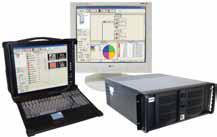Vendors Meet CALM Challenges Via Software

Digital Nirvana’s flagship Monitor IQ offers loudness monitoring and audio logging capability that includes Minnetonka Audio Software’s AudioTools family of measurement products
LOS ANGELES: Beginning Dec. 13, U.S. television program providers will be required to not only meet loudness limits but also to demonstrate compliance through accurate logging and reporting of levels.
Initially introducing hardware products to control loudness during the transition from analog to digital transmission, manufacturers worldwide have increasingly been introducing software solutions—some standalone, some integrated into other platforms— that ensure and demonstrate compliance of file-based and streaming television audio.
ALLIANCES AND INTEGRATION
Digital Nirvana’s flagship Monitor IQ offers loudness monitoring and audio logging capability that includes Minnetonka Audio Software’s AudioTools family of measurement products. Broadly adopted by European broadcasters, Minnetonka software provides loudness monitoring and logging of most audio standards, including Dolby Digital, Dolby Digital Plus, and Dolby E.
“Like many aspects of digital audio processing, loudness monitoring is extremely complex,” said Ned Chini, vice president of sales and marketing for Digital Nirvana. “Our customers can rely implicitly upon Minnetonka Audio’s software within Monitor IQ to evaluate all common audio formats in their plant, and alert them whenever audio loudness exceeds acceptable limits.”
Thomson Video Networks announced a strategic partnership at the 2012 NAB Show that allows the company to integrate Jünger Audio’s Level Magic into its ViBE encoding platform. The technology will be incorporated into new ViBE products beginning Q3 2012, the company reports. ViBE EM4000 and VS7000 users will also be able to upgrade their software.
Jünger Audio has launched a new Loudness Logging Toolset software upgrade that operates with the company’s entire range of leveling hardware processors, including recent versions of the C8000 system’s Level Magic II cards, and enables broadcasters to monitor in real time or analyze previously stored loudness log files offline. The software can be licensed per Windows PC and is USB dongle protected.
Get the TV Tech Newsletter
The professional video industry's #1 source for news, trends and product and tech information. Sign up below.

Miranda’s Kaleido-Solo loudness monitoring and logging system is a key component of its new end-to-end, loudness monitoring, logging and correction solution.
Linear Acoustic’s AERO.file, designed in collaboration with RadiantGrid Technologies, offers multiband dynamic range and loudness control, up/downmixing and transcoding to a wide range of audio file formats. AERO.file passes through video streams of any type while separately performing audio functions.
“By combining our AERO.qc processing with RadiantGrid transwrapping and TrueGrid transcoding technologies, users will be able to correct and format converted audio all within one very fast solution,” explained Tim Carroll, founder/president, Linear Acoustic.
Mediaproxy out of Australia, specializes in monitoring and logging solutions, so it should come as no surprise that the company added a loudness component to its LogServer and LogServer ASI products earlier this year. According to Erik Otto, CEO, Mediaproxy, “Our goal with loudness monitoring technology was twofold. Firstly, it had to enable broadcast service providers to address and maintain loudness regulations around the world. Secondly, access to loudness data needed to be seamless to enable users to easily export or burn-in data into sub clips as proof of compliance to address complaints efficiently. We have addressed both at the highest possible level and at no additional cost to customers when purchasing LogServer systems.”
AVOIDING THE REMOTE
Miranda Technologies has added segment- aware loudness monitoring and logging to its Kaleido series multiviewers and real-time loudness correction processors. Miranda’s Enterprise Suite also now offers file-based processing, applying loudness correction while maintaining the original content’s full dynamic range. Miranda’s new Intelligent Automatic Loudness Correction automatically detects whether to apply processing or pass through processed content.
As Marco Lopez, Miranda’s senior vice president, infrastructure, routers and monitoring, commented, “Loudness control is not just about compliance, it’s also about preventing viewers from reaching for their remotes to adjust the volume. As everyone is all too aware, that remote can also tune the television to a competitor’s channel.”

Triveni StreamScope MT-40
Qualis Audio announced a firmware update in April for its Sentinel Surround Sound Audio Monitor that allows simultaneous loudness measurement of a surround sound program and its stereo downmix. The update also enables loudness measurement according to BS.1770- 1 or BS.1770-2, and automatically creates reports of loudness conformance with CALM Act requirements.
Tektronix has integrated the audio loudness correction technology used in Dolby’s DP600 Program Optimizer into its Cerify automated file-based quality control platform. The collaboration allows Cerify to test audio/ video content and automatically correct audio content in real time based on those test results.
The single-step combined QC and correction process benefits operators through lower capital expenditures, reduced integration complexity and shorter workflow length, according to Tektronix. Cerify scales to run on a range of platforms from standalone Windows-based workstations to enterprise-wide solutions that interface to third party automation or asset management systems.
Triveni Digital has enhanced its Stream- Scope MT-40 real-time DTV transport stream analysis and verification product to include CALM support. The new capabilities allow users to monitor and analyze audio loudness according to BS.1770 and continuously log and export accurate loudness measurements of broadcasts in real time, while additionally providing evidence of CALM Act compliance. StreamScope MT- 40 provides the same level of analysis for mobile DTV as for terrestrial DTV.
Of course, even hardward has its “soft” side: TSL’s PAM2 MK2 recently underwent some enhancements that allow the export of onboard bargraph, loudness and data displays from the SDI monitor output to an outboard video monitor or to the production staff facility-wide via the plant’s SDI routing infrastructure.
Harris has added loudness compliance to its Videotek MSA-100 and MSA-300 Multi-Source Analyzer Series products. The new option, dubbed MSA-OPT-LOUD, measures input signals and issues alarms for non-compliant audio.
Harris showed a software upgrade prototype at this year’s NAB that integrates its LLM-1770 loudness logger and monitor with Harris ADC automation. The upgrade provides as-run records of loudness levels for recently aired programming.
Volicon extended the capabilities of its Observer loudness monitoring module earlier this year, enhancing its graphing, reporting and real-time alert features. In order to compare the ad loudness to surrounding content, Volicon’s Observer system measures momentary, short-term and integrated measurements, with adjustable short-form (less than two minutes) and long-form (days) time frames.
The platform also includes A/V logging and an array of measurement functions for demonstrating compliance, including the ability to view and export A/V affidavits with audio, video and frame-accurate loudness measurements burned in, thereby enabling fast resolution of loudness complaints.
Steve Harvey began writing for Pro Sound News and Surround Professional in 2000 and is currently senior content producer for Mix and a contributor to TV Tech. He has worked in the pro audio industry—as a touring musician, in live production, installed sound, and equipment sales and marketing—since November 1980.
